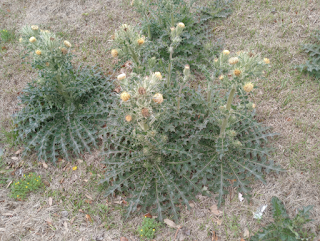Note from the Author: This is an update on a weed I covered on May 12th 2022.

This is a multi-stalked specimen, it's crown was probably damaged by a mower and it ended up with several growing points as a result. 
This is what a spent flower looks like. Flowers don't last long on Horrid Thistles. 
These are flowers that have yet to open. 
Look at the array of leaves at the bases of these plants! 
This little one is probably a first year plant.
Common Name: Horrid Thistle
Other Common Names: Bristle Thistle, Bull Thistle, Purple Thistle, Spiny Thistle and, Yellow Thistle and, in older publications it may be called Horrible Thistle.
Botanical Family: Asterceae (The Aster Family)
Botanical Latin Name: Cirsium horridulum
Description & Habitat: Horrid Thistle is an upright spiny native plant that may be an annual, biennial or perennial. It is typically found along roadsides and on the sides of drainage ditches in full or partial sun exposure. Horrid Thistle prefers sandy soil that is moist but not constantly wet. This plant reproduces exclusively by seed and its flowers are typically purple, but some specimens may be a golden-orange color. The leaves on this plant emerge from a central rosette and are borne alternately on its compressed main stem. The leaves are lobed and carry a lot of spines, and are usually a medium to dark green in color and have a fuzzy underside. It is not uncommon for this plant’s flower stalk to reach up to eight feet tall on mature specimens. Older publications may list the botanical latin name of this plant as (Carduus spinosissimus).
When & What to Harvest: The stalks, de-spined leaves and roots as well as unopened flower bud bottoms are fully edible. The only real reason this plant isn’t more known for forage circles is that you can’t really harvest from first year plants and you have to remove the spines. Spines on this plant will not cook down, so that is a barrier to eating it. The trick is to get as much leaf as is possible with a focus on the nutritious leaf midrib, just make sure to rub off the fuzz on the underside before cooking or eating raw. Older stems can also be used to make cordage as they become very fibrous, so in a survival scenario being able to make rope might save your life. As a final note for uses of this plant, I have read in a few decently credible sources that the Seminole Native Americans once made blowgun darts from this plant.
Edible Related Plants: Most true thistles are straight up edible.
Similar Dangerous Species: None are known.
Recipe: Stewed Thistle
Ingredients:
4 De-spined flower stalks of Horrid Thistle with the outer skin removed.
2 Cloves of Garlic
1 cup of Chicken or Mushroom broth
1 Teaspoon of Worcestershire Sauce
Instructions:
1. Put Sauce and Bullion in a sauce pan and heat enough to see steam.
2. Chop the Thistle Stems into 1” pieces and place inside your pot.
3. Chip up the garlic, add to pot.
4. At this point I like to add other seasonal vegetables but Dandelion or Chickweed are good options.
5. Cook until all ingredients are soft enough to eat; this may be 10 to 20 minutes depending on your stove.
6. Serve with rice.
Additional Information: (If applicable)
https://plants.ces.ncsu.edu/plants/cirsium-horridulum/
Where to get seed or Bare Root Plants:
I could not find a credible source for seeds or plants.
With all that garden goodness covered this is the part of the blog where I have to advertise for the Fayetteville City Market. Now I know you readers probably don’t much like advertisements, but my booth at the City Market helps to cover the costs of running the test garden and literally maintains the Research & Development budget that is used to bring you the information that has made up the backbone of this blog. In addition to being able to process card payments we now take CashApp payments so your payment options for my product have tripled. With that said; if you want to get some GMO-free, Organic fruit, herbs, flowers and perennials, come on down to the Fayetteville City Market on 325 Maxwell Street in downtown Fayetteville between the hours of 9:00 am and 1:00 pm on Saturdays. Even in bad weather the market goes on though you might have to look for me under the ‘arches’ of the Transportation Museum’s front entryway.
For those of you wondering what plants are going to be at the market this weekend here is the list.
Spring Plants:
Chicory, Italian
Chia
Ground Cherries, Perennial
Okra, Baby Bubba
Pepper, Shishito
Pepper, Ghost
Sorrel, Raspberry Dressing
Swiss Chard, Red
Tomato, Cherokee Purple
Tomato, Chocolate Cherry
Tomato, Midnight Snack
Tomato, Lemon Boy
Tomato, Sungold
Ornamental & Flowers:
Castor Bean, Giant
Poppy, California
Marigold, Giant Mission
Marigold, Eskimo
Soil Amendment Products:
Carolina Gold, Live Mushroom Compost – 18 Gallon Tote*
Carolina Gold, Live Mushroom Compost – 3 Gallon Bag
Carolina Gold, Live Mushroom Compost – 1 Gallon Bag
Carolina Gold, Enhanced Potting Soil – 1 Gallon Bag
*The 18 gallon tote is by special order only and is delivered to any address within the Fayetteville city area.
How to stay in Contact with Us!
All you need to keep up with all our activities is to have a Nextdoor account and to look for the ‘Sustainable Neighbors of Fayetteville’ group and ask to join! You don’t have to live in Fayetteville to join us! Feel free to ask all your garden questions of our knowledgeable membership and post your cool garden pictures.
Sustainable Neighbors of Fayetteville
Also please take a gander at the YouTube version of this blog:
The Videos: Look Here
>Newest videos (2): Chickweed Harvest, Hoan Ngoc Flowers
Meetings are still going on! Our next (unofficial) meeting is April 19th at the Fayetteville City Market at 325 Franklin Street between 9:00 am and 1:00 pm.






